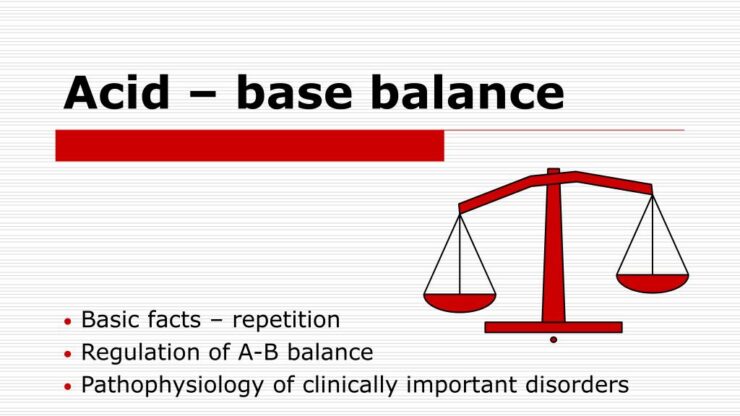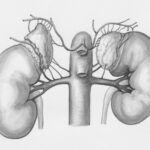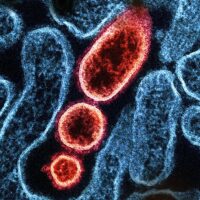Regulation of Acid-Base Balance
Importance of Acid-Base Balance
Balancing acids and bases is crucial for proper metabolic functions. The behavior of any solution is influenced by the concentration of free hydrogen ions ([H+]), measured as pH. pH represents the negative logarithm of hydrogen ion concentration:
pH = -log[H+]
The pH level depends on the balance between bicarbonate ions ([HCO3]) and carbon dioxide (CO2). CO2 concentration is managed by the lungs, while bicarbonate ions, which act as a base, are primarily processed in the kidneys. In plasma, CO2 dissolves to form carbonic acid (H2CO3), which is the main acidic component of blood. Since direct measurement of H2CO3 is challenging, the acid component is indicated by CO2 concentration. Normally, the CO2 to HCO3 ratio is around 1:20. An increase in acid leads to acidosis, while an increase in base results in alkalosis.
Buffer Systems in Acid-Base Regulation
Several buffer systems help maintain acid-base balance:
1. Bicarbonate Buffer System: The most crucial extracellular buffer, produced by the kidneys, with the highest buffering capacity.
2. Hemoglobin Buffer System: The primary intracellular buffer in blood.
3. Protein Buffer System: An extracellular buffer system that works alongside bicarbonate, represented by plasma proteins.
4. Phosphate Buffer System: Participates in hydrogen ion excretion in renal tubules, but has a lesser role in blood.
Cellular Mechanisms of Acid-Base Regulation
Blood pH changes activate cellular mechanisms to maintain hydrogen ion concentration in the extracellular fluid:
– When pH Increases (Alkalosis): Hydrogen ions move from cells to extracellular fluid, while potassium ions enter the cells, often resulting in hypokalemia.
– When pH Decreases (Acidosis): Hydrogen ions enter the cells as potassium ions leave, which can cause hyperkalemia.
These processes maintain electro-neutrality, ensuring that the sum of positive and negative charges (cations and anions) remains equal. The exchange of hydrogen and potassium ions between extracellular fluid (ECF) and intracellular fluid (ICF) must be balanced.
Organ Mechanisms of Acid-Base Regulation
1. Respiratory Regulation:
The lungs manage volatile acid (carbon dioxide) excretion. Plasma CO2 content depends on alveolar ventilation. pH changes stimulate brainstem chemoreceptors, leading to compensatory adjustments in the respiratory rate. In acidosis, increased alveolar ventilation reduces PaCO2, helping to normalize pH. These changes occur rapidly but take 12 to 24 hours to stabilize the acid-base status. Alkalosis induces hypoventilation, raising PaCO2 and lowering pH.
2. Renal Regulation:
The kidneys have the most complex and effective mechanisms for acid-base regulation through:
– Bicarbonate Ion Reabsorption in Proximal Tubules
– Bicarbonate Ion Regeneration in Distal Tubules
– Hydrogen Ion Excretion
CO2 reacts with water in renal tubular cells to form carbonic acid, which dissociates into H+ and HCO3-. This reaction is catalyzed by carbonic anhydrase. Bicarbonate ions enter the systemic circulation and are secreted into the renal tubule lumen, where they are reabsorbed in exchange for sodium ions, maintaining electro-neutrality. The secreted hydrogen ions react with filtered bicarbonate to produce carbonic acid, which then dissociates into CO2 and water. Hydrogen ion excretion continues once all bicarbonate is reabsorbed. HPO4- ions bind with secreted hydrogen ions, forming H2PO4- that is excreted in urine, while HCO3- is reabsorbed into the blood. After these mechanisms are exhausted, the kidneys switch to the ammonia buffer system (NH3/NH4+), primarily derived from glutamine deamination. NH3 crosses tubular cell membranes freely and binds with protons in urine to form NH4+, which cannot be reabsorbed. This process is known as ammoniogenesis.
Engage with Us:
Stay tuned for more captivating insights and News. Visit our Blogs and Follow Us on social media to never miss an update. Together, let’s unravel the mysteries of the natural world.
✦✦✦✦✦




















